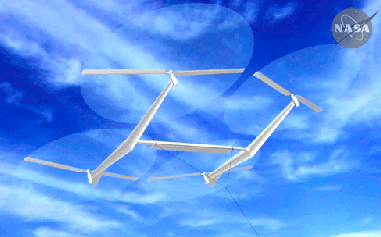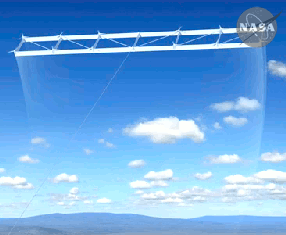NASA Investigates Airborne Wind Turbines for Future Energy Production

What a future airborne wind turbine may look like
Although offshore wind turbines have the advantage of not having to take up valuable dry-land resources (as Kevin Costner may say in Waterworld), one the main disadvantages of wind turbines at sea level (or, to be accurate at a few meters above sea level taking into consideration their tower structures) is the relatively low power of the wind that turns them. It's a fact of nature that as you go further upwards into the sky the speed of the wind increases. At a height of 610 metres (2,000 feet) the speed of the wind is between 2 and 3 times the velocity at ground level.
The relative power provided by wind equates to the cube of the relative velocity, so this means that at 610 metres the power is 8 to 27 times that at ground level. If you travel up higher the figures become even more impressive. If an airborne turbine were to travel up into the jetstream at 9,150 metres (30,000 feet) the wind there is travelling at 150 miles per hour, which would produce 20,000 to 40,000 watts per square metre rather than just the 500 watts per metre which turbines at ground level produce. That's a multiple of over 40 times the power. In addition to these immense power-multiple benefts, the flow of wind is much more constant the higher up you travel, which would give a far more reliable source of power.
Wouldn't it be nice therefore if we could somehow create turbines that would fly in the sky like a parchute, kite, ballon or blimp to harness the energy of these high-altitude winds? This is exactly what NASA aerospace enginee Mark Moore is investigating with a $100,000 federal government grant at NASA's Langley Research Center. This is the very first time that federal funding has gone into such research.

We could see wind turbines flying in the skies like kites in the future.
The actual power producing mechanisms could be a turbine located at the back of a blimp which is shaped in such a way that the blimp funnells the wind straight through the turbine for example, or rotating vanes generating power on a balloon. As well as the high and reliable power benefits, another advantage of flying turbines is that they do not take much room on the ground. All that is needed is a small space for tethering. Nanotubes could be used as high strength tethers.
One particular aspect that needs to be considered is the possibility of airborne wind turbines interrupting fligh paths of aircraft. Commercial jet aircraft, including jumbo jets, generally cruise at an altitude of 25,000 to 37,000 feet. Normally the further the flight is, the higher they travel. Personal aircraft like Cessna planes or other propellor powered airplanes may only cruise at around 5,000 to 6,000 feet. These smaller aircraft could possibly fly around a protection area of, for example, 2 miles around the airborne turbine farm, but it would probably be impractial to require commercial aircraft to zig-zag their way around multiple airbone hazards on their long journeys.
The best option may be to locate the airborne turbines offshore. At a distance of 12 miles offshore, there is either very little or no low altitude flight. There would be virtually no additional cost of tethering an aerial turbine farm offshore, as they do not require the type of colossal platforms that traditional offshore wind turbines use. In addition, locating the turbine tethers offshore would keep the land available for other uses.
It may not be the sole solution for all our future power needs, but it could will be one of the ideas which adds to the combination of sustainable energy production to be employed by generations to come.

Solar Powered Plane Completes 26 Hour Day and Night Flight
- Renewable Energy:
- Login to post comments
